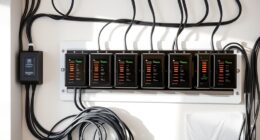To build a winning strategy, leverage behavioral triggers that respond to user actions. These triggers can increase your engagement rates by up to 70% and guarantee your marketing is timely and relevant. Start by defining clear goals and objectives that align with your business strategy. Use automation to streamline your campaigns, sending personalized messages based on user behavior like cart abandonment. Adjust your campaigns as needed, focusing on performance metrics to boost conversions. With this approach, you can create meaningful interactions that foster loyalty and drive sales. Discover more strategies to enhance your success along the way.
Key Takeaways
- Utilize behavioral triggers to initiate timely, relevant communication based on user actions, enhancing engagement and conversion rates significantly.
- Implement SMART marketing objectives to align campaigns with business strategy and measure the impact of behavioral triggers on customer behavior.
- Automate campaigns to streamline lead nurturing and improve efficiency, recovering lost sales through timely follow-ups and personalized interactions.
- Monitor performance metrics and conduct A/B testing to refine strategies, ensuring messages resonate with target audiences and drive conversions.
- Continuously analyze audience engagement patterns and adjust campaigns based on insights to maintain relevance and optimize performance.
Understanding Behavioral Triggers
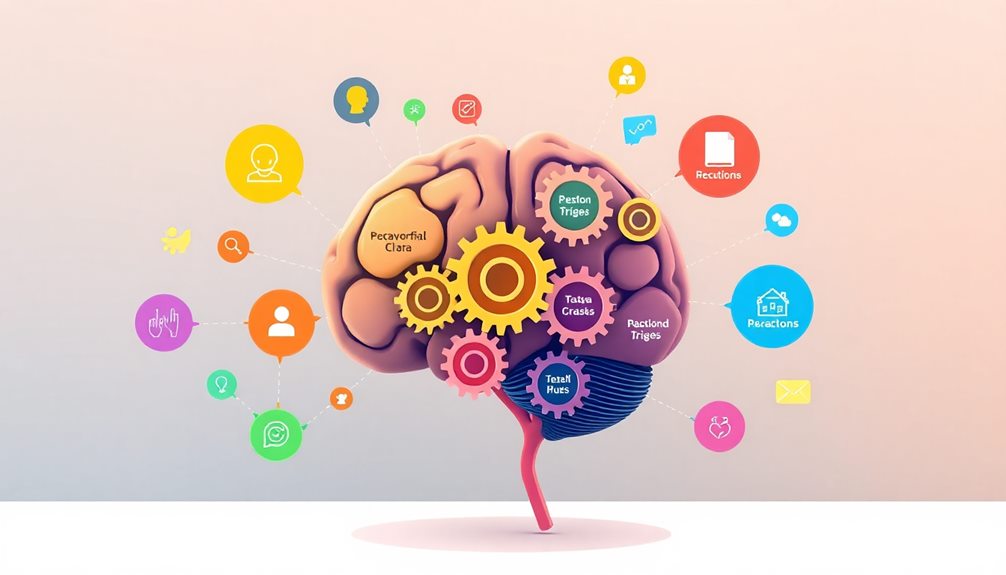
How do behavioral triggers transform your marketing strategy? These automated responses initiate communication based on specific user actions, like clicks and purchases, ensuring your messaging hits the mark.
By leveraging behavioral triggers, you can cater to customer needs in real-time, enhancing the relevance and timeliness of your outreach. Incorporating strategies for elevating SEO alongside behavioral triggers can further optimize your marketing efforts.
With marketing automation, you can set up campaigns that respond to user behaviors, leading to a remarkable 70% increase in open rates and recovering up to 18% of lost sales from cart abandonment. This not only boosts your conversion rates but also nurtures leads effectively.
Understanding the different types of behavioral triggers—engagement, time-based, and feedback—enables you to craft targeted campaigns that resonate with various audience segments.
By monitoring performance metrics and conducting A/B testing, you can gather valuable insights to optimize your strategies further.
Ultimately, mastering behavioral triggers helps you deliver personalized content that aligns with user engagement, making your marketing efforts more effective.
Embrace this approach, and watch how it transforms your marketing landscape, driving better results and deeper connections with your audience.
Importance of Trigger-Based Campaigns

Trigger-based campaigns keep your audience engaged by delivering timely and relevant content tailored to their actions.
By leveraging advancements in Natural Language Processing (NLP), you can enhance customer interactions and personalize responses, making your campaigns even more effective.
When you respond to user behavior, you not only capture their attention but also boost engagement rates considerably.
This approach makes your marketing efforts more effective and enhances your overall strategy.
Enhanced Engagement Rates
Recent studies show that campaigns leveraging behavioral triggers can boost engagement rates by up to 70%. This impressive increase isn't just a number; it translates to more meaningful interactions with your audience. When you use personalized content tailored to users' actions and preferences, you're not just sending messages—you're creating connections.
For instance, understanding the importance of virtual birthday party ideas can help you craft more relatable and engaging content for your audience.
Take cart abandonment emails, for instance. These trigger-based campaigns can recover up to 18% of lost sales, showcasing how effective timely and relevant messaging can be. By reaching out to customers who've shown interest but didn't complete their purchase, you're engaging them in a way that feels relevant and personal.
Moreover, engagement triggers, such as those generated from downloads or sign-ups, nurture leads effectively. These targeted communications can greatly improve conversion rates, helping you build stronger relationships with potential customers.
Implementing data-driven insights from your trigger-based campaigns enhances overall customer experience, leading to improved retention. By focusing on behavioral triggers, you're not just increasing engagement rates; you're also fostering loyalty and encouraging continued interaction with your brand.
Timely, Relevant Content
There's no denying that timely, relevant content is essential in today's fast-paced digital landscape. When you harness behavioral triggers, you can deliver messages that resonate with your audience based on their actions. This approach can boost conversion rates by up to 70% compared to non-triggered communications.
Automated responses, like cart abandonment emails, can salvage about 18% of lost sales, showcasing the power of responding promptly to customer behavior. By using behavioral triggers, you guide prospects through a thoughtful sequence of touchpoints, enhancing lead nurturing and engagement rates.
Tailoring your trigger-based campaigns to individual preferences not only increases personalization but also guarantees your messaging remains relevant. This data-driven strategy allows you to craft timely content that speaks directly to your audience's needs.
Moreover, successful implementation of these triggers streamlines your marketing processes, freeing up time for you to focus on high-priority tasks while maintaining consistent communication with leads.
Defining Marketing Campaign Objectives

When defining your marketing campaign objectives, it's essential to establish clear goals that align with your overall strategy.
This way, every action you take can effectively contribute to your broader business aims.
Plus, measuring campaign effectiveness helps you track progress and adjust your tactics as needed.
Establish Clear Goals
Establishing clear goals for your marketing campaigns is essential to guaranteeing they align with your overall business objectives. When you define specific, measurable goals using frameworks like SMART, you can effectively guide your efforts.
This clarity helps you set up workflows that integrate behavioral triggers, allowing you to respond to customer actions more effectively.
Define metrics for success, such as conversion rates and engagement levels, to measure the impact of your campaigns on customer behavior. This way, you can assess whether your strategies are working and how they can be improved.
With well-articulated goals, you can segment your audience more effectively, tailoring your messaging to resonate with specific needs and interests.
Regularly reviewing and adjusting your campaign goals based on performance data will lead to better outcomes. This adaptability makes your marketing more responsive and guarantees you're consistently meeting your objectives.
Remember, clear goals not only enhance the effectiveness of your trigger-based strategies but also empower your team to stay focused and motivated.
Align With Overall Strategy
Defining marketing campaign objectives is vital for making sure your trigger-based strategies align with your overall business goals. When you establish clear, measurable objectives, like boosting conversion rates or cutting cart abandonment, you create a roadmap for your marketing campaign that leverages behavioral triggers to automate engagement.
By aligning these triggers with different stages of the customer journey, you guarantee you're delivering the right message at the right time. This relevance not only enhances engagement but also leads to a higher return on investment. For instance, targeted messages based on user behavior can remarkably reduce drop-off rates and increase sales.
It's also important to regularly review and adjust your campaign objectives based on performance data. This practice helps you optimize your triggers and maintain alignment with evolving business strategies.
Successful campaigns often balance short-term goals, like immediate sales boosts, with long-term objectives that nurture sustained customer relationships through consistent trigger use.
In short, defining your marketing campaign objectives with precision allows you to use behavioral triggers effectively, driving meaningful engagement and achieving your business goals.
Measure Campaign Effectiveness
To effectively measure campaign effectiveness, it's imperative to begin with clearly defined marketing objectives. Organizations with documented goals are 376% more likely to report successful outcomes.
By setting SMART objectives—specific, measurable, achievable, relevant, and time-bound—you can track your campaign's performance and make informed decisions based on data.
Here's how to define your marketing objectives:
- Identify Your Goals: Determine what you want to achieve, whether it's increasing brand awareness or boosting sales.
- Select KPIs: Use key performance indicators like conversion rates, customer acquisition costs, and ROI to quantify your success.
- Implement A/B Testing: Experiment with different elements, such as subject lines or calls-to-action, to improve campaign performance by up to 49%.
- Analyze Regularly: Consistently review your campaign data to spot trends and areas needing improvement, enhancing lead nurturing effectiveness by an average of 50%.
Planning Customer Touchpoints

Planning customer touchpoints is vital for guiding potential clients through their journey with your brand. Start by mapping the customer journey to align your content with specific stages, guaranteeing you effectively address potential needs.
Incorporate behavioral triggers in your outreach, like sending educational emails right after a prospect downloads a resource. This kind of targeted communication helps guide them smoothly through the marketing funnel.
To enhance your strategy, consider A/B testing various touchpoint approaches. This will provide you with data-driven insights into what resonates best with your audience, allowing for optimization of your campaigns.
Additionally, leverage automation to facilitate timely follow-ups based on user engagement. For instance, schedule live demos for leads who show interest in specific product features.
It's essential to continuously monitor customer interactions and adjust your touchpoint strategies accordingly. This guarantees your communications remain relevant and engaging, ultimately leading to higher conversion rates.
Implementing Automation Strategies

When it comes to implementing automation strategies, understanding the benefits can transform your marketing efforts.
You'll want to explore the various trigger types available and adopt best practices to maximize your impact.
Benefits of Automation
Implementing automation strategies greatly enhances your marketing efforts, especially when you leverage behavioral triggers. By using automation software, you can create timely, personalized interactions that resonate with your audience.
Here are some key benefits you can expect:
- Improved Engagement: Benefit from a 70% increase in open rates for your campaigns, leading to deeper connections with your audience.
- Recover Lost Sales: Cart abandonment emails can help you recover up to 18% of lost sales, reminding customers at the right time to complete their purchases.
- Streamlined Lead Nurturing: Trigger-based campaigns guide prospects through a logical sequence of touchpoints, increasing your conversion rates.
- Optimized Marketing Spend: Data-driven insights allow you to target effectively, reducing costs associated with traditional marketing methods.
Trigger Types Overview
Many marketers find that understanding different types of behavioral triggers is vital for optimizing their automation strategies.
Behavioral triggers can be categorized into several types, each serving distinct purposes in automating customer outreach. Engagement triggers, like downloads or sign-ups, respond to specific user actions and can greatly boost personalized content delivery, improving conversion rates by up to 70%.
On the other hand, time-based triggers are essential for maintaining engagement over time. They remind customers about upcoming events or follow up after periods of inactivity to keep your brand top-of-mind.
Additionally, purchase triggers, such as upselling or cross-selling emails based on previous purchases, can enhance customer lifetime value. They encourage repeat business and increase average order value.
Best Practices Implementation
To successfully implement automation strategies, you need to start with clear goal definitions that align with your overall marketing objectives. This clarity guarantees your campaigns are effective at delivering the right messages based on behaviors that trigger which system.
Here are some best practices to take into account:
- Utilize A/B Testing: Experiment with different triggers and messaging to find what resonates most with your audience. This approach can greatly enhance engagement rates and conversion metrics.
- Monitor Performance Metrics: Continuously track the performance of your trigger campaigns. Gathering data-driven insights helps you make informed adjustments and optimizations, streamlining your marketing efforts.
- Guarantee Compliance: Adhere to data protection regulations during implementation. This not only maintains customer trust but also helps you avoid legal complications.
- Encourage Customer Feedback: After each campaign, seek feedback from your customers. Their insights can help you refine and improve future trigger strategies, enhancing personalization and overall customer experience.
Lead Scoring and Engagement
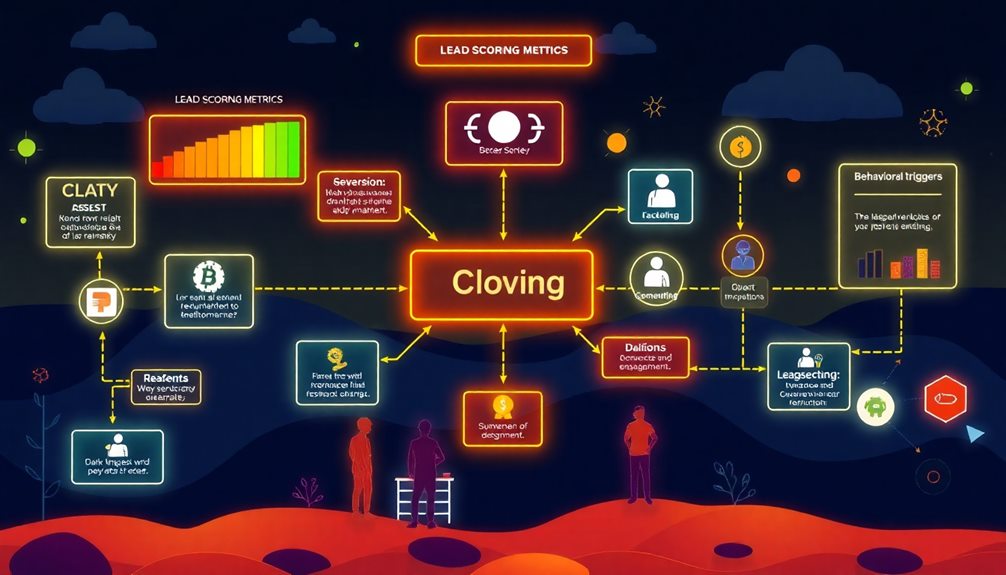
A solid lead scoring system is essential for effectively managing your sales pipeline. By assigning numerical values to leads based on their engagement behaviors, you can prioritize prospects for follow-up. Actions like email opens, link clicks, and form submissions contribute to a lead's score. Higher scores indicate greater interest and readiness to convert.
To visualize how lead scoring works, consider the following table:
| Engagement Action | Score Impact |
|---|---|
| Email Open | +5 |
| Link Click | +10 |
| Form Submission | +20 |
| Social Media Interaction | +8 |
Implementing behavioral triggers allows you to adjust lead scoring in real-time, guaranteeing you respond promptly when leads hit a specific engagement threshold. Research shows that companies using lead scoring can boost sales productivity by up to 30% since they focus on the most promising leads. Regularly reviewing and adjusting your lead scoring criteria based on evolving customer behaviors guarantees your engagement strategies remain relevant and effective. By doing this, you can maintain a dynamic and responsive sales approach that drives conversion rates higher.
Adjusting Campaign Sequences
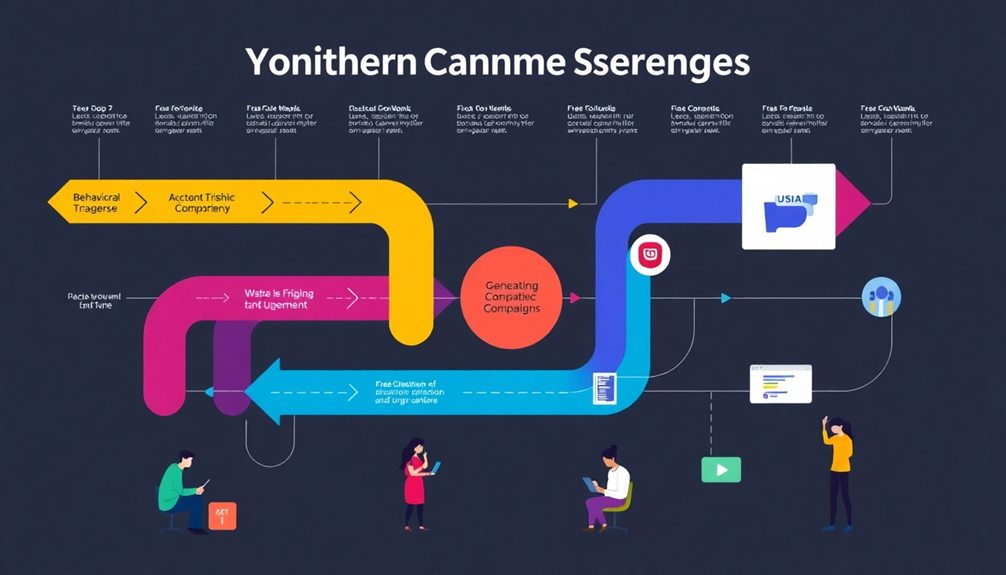
Adjusting campaign sequences based on lead engagement can greatly boost your conversion rates. By recognizing how triggers are incredibly helpful, you can tailor your outreach strategy effectively.
Here's how to optimize your campaigns:
- Identify Engagement Patterns: Use data analytics to track actions when certain behaviors occur, such as clicks or downloads. This helps you understand what resonates with your audience.
- Implement Lead Scoring: Develop a scoring system to prioritize high-engagement prospects. This way, you can adjust your messaging to focus on those most likely to convert.
- Nurture Non-Engaging Leads: For leads that aren't engaging, provide educational content until they show interest. Once they interact, you can shift to more targeted communication.
- A/B Test Your Sequences: Experiment with different campaign sequences to find the most effective touchpoints. Monitor the results to continuously refine your approach.
Managing Customer Engagement

Managing customer engagement effectively hinges on understanding and responding to behavioral triggers. By automating your engagement efforts, you can deliver timely and relevant content based on user actions, leading to impressive results like a 70% increase in open rates for triggered campaigns.
These behavioral triggers allow you to nurture leads more effectively, ensuring you prioritize follow-up actions based on their level of interest. For instance, implementing cart abandonment triggers can help you recover up to 18% of lost sales, effectively enhancing customer engagement with gentle reminders.
Personalizing content delivery through these triggers not only boosts engagement rates but also greatly improves your lead nurturing efforts, potentially increasing conversion rates by up to 50%.
Don't forget to monitor your engagement metrics closely, such as clicks and downloads. These metrics are critical for lead scoring and can guide you in adjusting your campaign flows.
Analyzing Campaign Performance
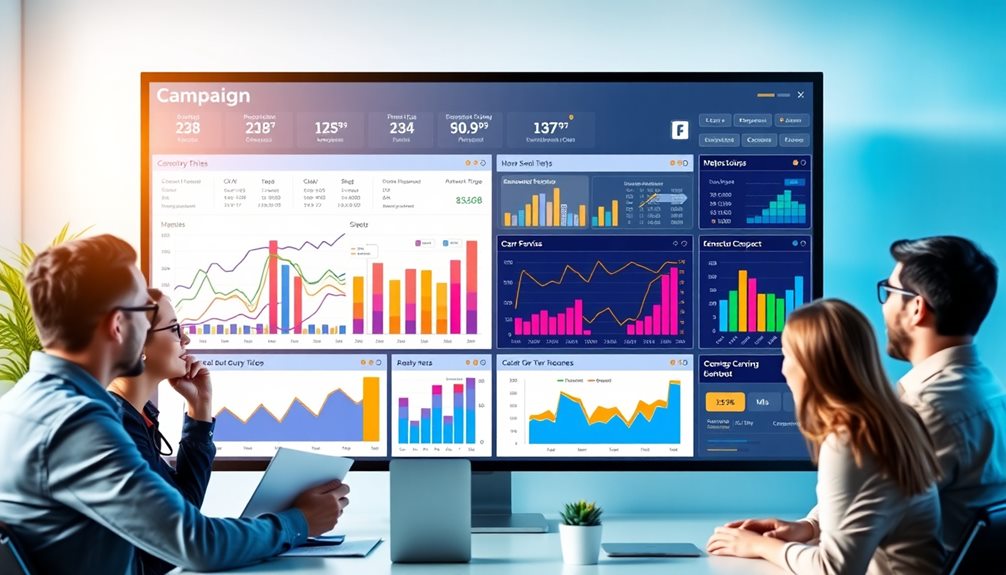
Effective customer engagement relies on a solid understanding of how your campaigns perform. Analyzing campaign performance is vital for refining your strategies and optimizing results. Here are key steps to enhance your approach:
- Establish Control Groups: Benchmark results against various campaign strategies to measure overall effectiveness.
- Monitor Key Performance Metrics: Keep an eye on engagement rates, conversion rates, and ROI to evaluate the success of your trigger-based campaigns.
- Utilize Data Analytics: Analyze trends in customer interactions to gain real-time insights, allowing you to adjust your tactics based on actual behavior.
- Implement A/B Testing: Test different creative techniques within your campaigns. The insights gained will inform your future marketing strategies and necessary adjustments.
Continuous analysis and feedback loops are essential for optimizing your efforts. By regularly reviewing your performance, you can guarantee that your campaigns remain responsive to audience needs and preferences over time.
Best Practices for Success

A solid foundation in best practices can dramatically elevate your trigger-based campaigns' success. To start, utilize engagement triggers like cart abandonment emails, which can recover up to 18% of lost sales. When certain behaviors take place, such as a customer leaving items in their cart, these triggers the action automatically, prompting timely follow-ups that drive revenue and improve customer retention.
Next, personalize your content delivery based on behavioral triggers to enhance engagement. Personalized campaigns often achieve up to 50% better outcomes than generic communications. You should also execute a variety of A/B tests in your campaigns; data shows that optimizing through testing can lead to conversion rate increases of up to 50%.
Additionally, guarantee compliance with data protection regulations to avoid penalties. Integrating best practices for data privacy into your strategies is vital.
Frequently Asked Questions
What Are the Three Types of Behavioral Triggers?
There are three types of behavioral triggers you should know: engagement triggers, which respond to user actions; time-based triggers, which send reminders; and purchase triggers, which focus on customer buying behaviors for effective marketing.
What Is an Example of a Trigger Behavior?
An example of a trigger behavior is when you download an e-book. This action can prompt an automated follow-up email series, providing you with relevant content and nurturing your interest further down the sales funnel.
What Are Behavioral Triggers in Marketing?
Behavioral triggers in marketing are automated responses to user actions. They personalize messages, boost engagement, and increase conversions. You'll see reminders, follow-ups, and upsells, all designed to meet your needs at the right moment.
How Do Triggers Make Behaviour?
Triggers shape behavior by prompting immediate reactions to specific actions. When you engage with content, these triggers send timely messages, reinforcing your interests and guiding your decisions, ultimately enhancing your experience and encouraging further interaction.
Conclusion
Incorporating behavioral triggers into your marketing strategy is like planting seeds in a garden; with the right conditions, they'll flourish and yield great results. By understanding your audience, defining clear objectives, and managing touchpoints effectively, you can nurture customer engagement and drive conversions. Remember to automate wisely and adjust your campaigns based on performance insights. Embrace these best practices, and you'll cultivate a winning strategy that blooms over time, ensuring lasting success.








